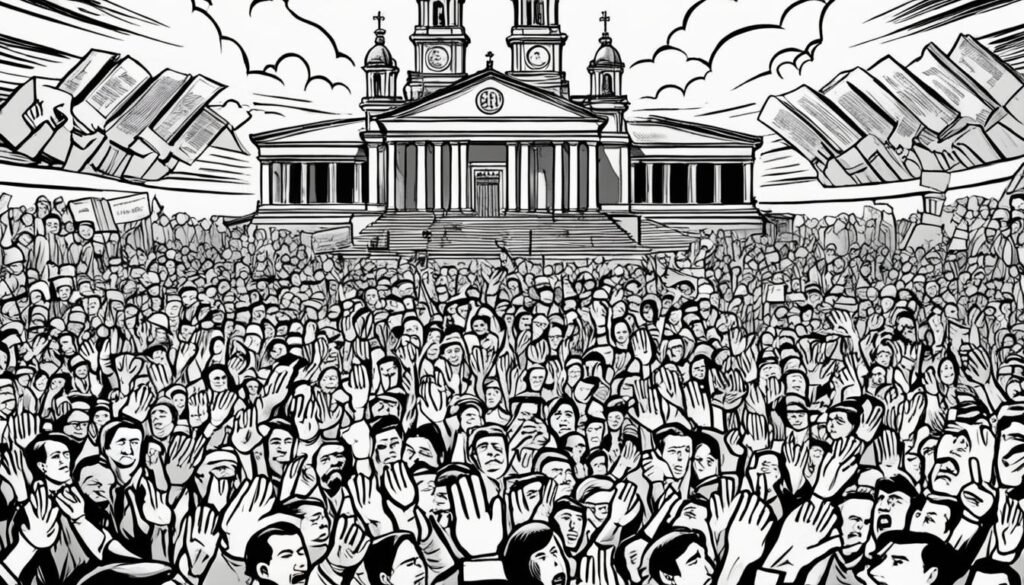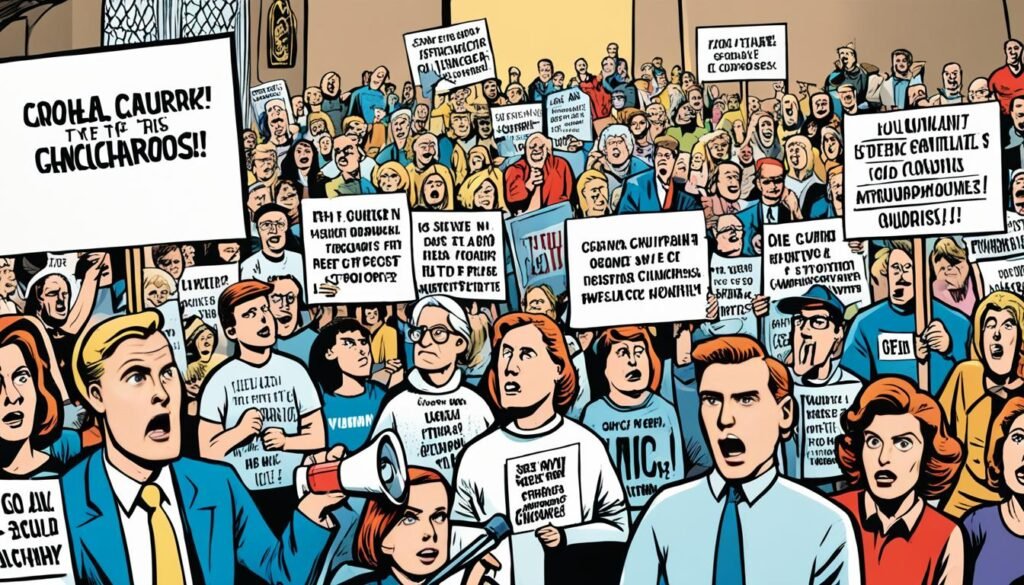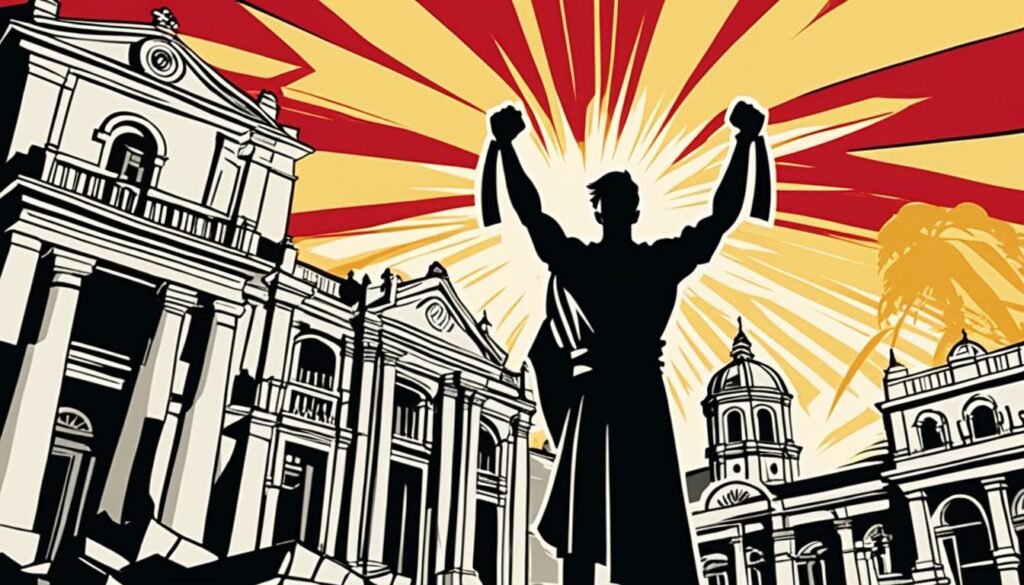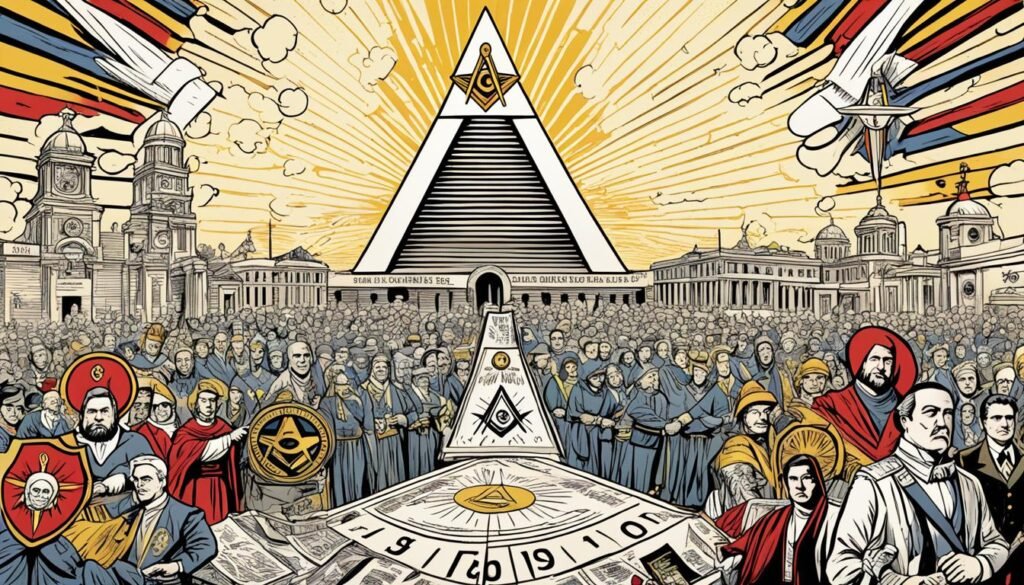The push for a secular Filipino identity during the Philippine Revolution stood against the Catholic Church’s long rule. Revolutionaries across the islands fought the Church’s far-reaching power. This was similar to the French Revolution, where the Civil Constitution of the Clergy led to the persecution and exile of many priests1. Thus, the Philippines’ fight echoed a common battle against the Church’s influence, seen in various times and places.
In this setting, anti-clericalism drove the push to separate church and state. This mirrored France in the 19th century, where laws barred clerics from teaching in public schools. This led to a formal separation between church and state in 19051. Such actions have helped shape Philippine secularism, creating a society where government and religious powers are separate.
Key Takeaways
- Revolutionary pushback against Catholic Church influence in Filipino society
- Historical parallels with French anti-clerical movements and secular policies
- Transition toward a secular Filipino identity during the Philippine Revolution
- Global comparisons of anti-clericalism, with echoes in post-communist states
- The critical role of anti-clericalism in church-state separation
The Historical Roots of Anti-Clericalism
The roots of anti-clerical feelings go back to a long history. This history shows a conflict between the desire for religious freedom and the power of the church. Specifically, the Roman Catholic Church. People were upset about the church’s moral issues and its control. They wanted the freedom to practice any religion and to have a government that is separate from religious institutions.
Freedom of Religion and Anti-Clerical Sentiments
Over the centuries, the idea of religious freedom became key in creating modern nations without religious control. Criticism grew against the church’s role in government matters. Historically, this criticism was clear in events like the European religious wars. Also, in France’s move away from Christianity during the French Revolutionanti-clerical sentiment2. These times led to the belief that the church and state should be separate. This separation is important to protect freedom for everyone.
The Roman Catholic Church’s Influence on Colonial Powers
The Roman Catholic Church spread its teachings and control in colonies. This happened in places like Latin America, Africa, and the Philippines. The church used papal decrees to control societies and national policies during colonization. In documents like “Iniquis afflictisque,” you see the clash between wanting religious freedom and the rejection of church control.2 Countries like Mexico and Spain faced persecution of Catholics. Figures like Miguel Pro and José María of Manila symbolized the fight for religious freedomRoman Catholic Church’s colonial influence2.
As nations broke free from colonial rule, they aimed to form secular governments. They saw the need for church-state separation to secure religious freedom. This acknowledgment is vital for a fair society. Through history, events, and key documents like “Mit brennender Sorge,” we see how important these ideas are globally. They show our shared desire to find the right place for religion in government.2.
Understanding Secularism and Its Role in the Revolution
The growth of secularism, seeking a secular state, was key in changing revolutionary ideas. This change made church-state separation a main goal. During political changes, pushing back against church power and supporting religious liberty helped create an independent secular society. Past revolutions show the fight for freedom against religious control in government. This is seen in the idea of political anti-clericalism.
Concepts of Secular State and Its Impact on Society
Secularism became key in revolutions, aiming for freedom from religious control. For example, clergy in the American Revolution showed how deep religious and patriotic feelings were mixed during big changes3. But, this time also showed big disagreements inside religions, like the Church of England and Quakers3. Secularism aimed to solve these issues, pushing for peace in a diverse society.
Secularism as a Response to Religious Institutions in Politics
When the French Revolution happened, a law on 2 November 1789 aimed to end the church’s control over land and money. This moved all Church property to the nation’s control4. This marked a shift to loyalty to a secular system over religious ties. It caused divides among believers that lasted for years4. This showed how religious power in politics can lead to conflict. Secularism became a shield against such issues.

Over time, the push for secularness and the pushback from churches show the ongoing effort to balance personal faith and public rule. From military chaplains in the Revolution to European clergy conflicted by oaths to secular laws, the growth of secularism reflects our attempts to mix the sacred and civic. This journey aimed to avoid a rule by religion or religious oppression34.
| Region | Religious Influence | Secularist Action |
|---|---|---|
| Americas | Religious inscriptions on battle flags | Movements for church-state separation3 |
| France | Church property ownership | Nationalization of Church assets4 |
In conclusion, secularism’s emergence has deeply changed politics and society. By pushing for a secular state, revolutions fought against religious control. This created a society based on religious freedom and secular governance.
The Interplay of Religion and Government During Spanish Rule
The era of colonial rule under the Spanish government created a tight link between church and state in the Philippines. This merger affected how the country was governed every day. Similar patterns were seen in Spain, showing it was a common trend. These actions often meant religious political intervention in government decisions, education, and policies, shaping society and personal lives.
Looking back at history, we can see the lasting effects of this union in modern Spain. A survey showed 67.8% of Spaniards are Catholic, with 2.2% practicing other religions5. The US government found Spain’s population was 48.5 million in 20165. This religious diversity today has roots in Spain’s past imperial policies.
In Spain, there’s a variety of religious beliefs. The country has around 1.7 million evangelical Christians and Protestants. There are about 900,000 immigrants in these groups5. The Muslim community counts 1.89 to 2 million members5. Spain also has 40,000 Jews and 900,000 Orthodox Christians5. Additionally, there are 110,000 Jehovah’s Witnesses and roughly 85,000 Buddhists5, showing a rich religious landscape.
Yet, the past church-state mix still affects religious freedom today. A report noted 191 religious freedom incidents in Spain at one time5. Some cases even led to violence. The Spanish government has tried responding by organizing a conference on religious intolerance. It also supports efforts to include Muslim youth better in society5.
This history of religion and government together shows Spain, like the Philippines, struggles with their past actions. The challenges they face today reflect the complex relationship between church and state through the ages.
| Religious Group | Population in Spain |
|---|---|
| Catholics | 67.8%5 |
| Evangelicals/Protestants | 1.7 million5 |
| Muslims | 1.89-2 million5 |
| Jewish Community | 40,0005 |
| Orthodox Christians | 900,0005 |
Anti-Clericalism and Its Connection to Secularism
Recent events have sparked new talks on anti-clerical movements. They show the clash between church power and secular beliefs. Today, the fight for secularization questions the line between faith and the rules of the land.
The Rise of Secular Ideologies Against Religious Authority
Secular beliefs are shaking up old institutions, changing how society and church power interact. Pope Benedict XVI spoke of an “aggressive anti-clericalism” that reminds us of the 1930s6. Spain shows this change well, with only 14.4% of its people going to mass often6.
Similarities and Differences Between Anti-Clericalism and Secularism
Anti-clericalism fights against religious bodies, while secularism wants a clear cut. The Pope’s visit to Spain showed both protests and support within the Catholic community6. Meanwhile, Spain’s laws on divorce, gay marriage, and abortion go against the Catholic norms6.
Spain’s Sagrada Familia church symbolizes this ongoing debate. Antoni Gaudi’s unfinished church reflects the talk between old and new, the holy and the common6.

The dance between anti-clerical attempts and secular ways shows how belief and secular rule are changing. Despite 73% of Spaniards claiming Catholic identity, the nation’s character is a blend of faith and a secular mindset6.
For more on the church’s role versus secular trends, read this analysis: Spain’s journey through religious transformation.
The Socio-Political Climate of the Philippine Islands Pre-Revolution
Before the Revolution, the Philippine society was a mix of Spanish colonial policy. This created a world where the church-state union was deeply rooted. The way the church leaders and the locals interacted was unfair. It took advantage of their faith. This unfairness helped spark a movement against the church’s power. The Spanish rule helped blend the church’s power into everyday life for Filipinos. This power became a key reason for people wanting change.
The Union of Church and State in Spanish Colonial Policy
The power back then was held by both the Spanish rulers and the church. This link was enforced strictly, leading to big changes in society. This setting was important because the church was not only into spiritual matters. It also had a big say in how things were run each day.
Religious Exploitation as a Catalyst for Anti-Clerical Movements
The unfair use of religion was something that really affected the Filipinos. This led to many acts of resistance. Looking at tissue-paper balloons in Mexico City in 1926, Filipinos saw a way to resist. These balloons were used to stand against the government’s unfair actions against the church7. The effort in Mexico to stop these 600 balloons showed a fight against religious unfairness.
This situation hinted at the big changes about to happen in the Philippines. The unfair acts by the church helped push the society toward these changes. These shifts were going toward a free and non-religious Filipino nation.
| Event | Action | Objective |
|---|---|---|
| Anti-government Propaganda | Balloon dissemination in Mexico City | Encourage catholic protest against anticlericalism7 |
| Police Task | Prevent launch of 600 balloons | Suppress anti-government propaganda7 |
The history of the Philippines is full of complex social and religious issues. These issues were at the heart of a major change in the country’s story. It’s in this setting that the strong will of the Filipino people started to bring about change. This change would leave a lasting mark on the country’s history.
Cultural Identity and Religious Imperialism in the Philippines
The search for cultural identity in the Philippines has been a long and complex journey. It’s woven through colonial history. The mix of religious imperialism and native beliefs created a unique culture that is still seen today.

Westernization and modernization brought new ideas and beliefs to the islands. Within 25 years of the first Christian conversions on Cebu, about 250,000 Filipinos had converted to Christianity8. This was a big change in the country’s religious scene, showing the power of conversion as an imperial tool.
Westernization and Modernization in the Context of Colonial History
Religious and cultural changes have left deep marks on society, found in historical texts and language efforts. An important work from 1610, “Arte y reglas de la lengua tagala,” was written to help priests learn Tagalog for better ministry8. It shows early attempts to shape local languages for colonial goals, highlighting the link between language change and colonial aims.
Religious Identity as a Tool in Imperialistic Agendas
The “Doctrina Christiana,” published in 1593 in both Tagalog and Spanish, aimed to embed religious beliefs in Filipinos’ daily lives8. This book, using xylography, was one of the first to combine religious imperialism with education. It made the Catholic Church a key part of Filipino cultural identity under Spanish rule. Other works, like the 1886 “Pagduao sa santisimo sacramento sa altar, cag sa mahal na Virgen,” printed in Hiligaynon, focused on devotion and helped shape the evolving spiritual identity8.
Jose Rizal’s novels, “Noli me tangere” and “El filibusterismo,” exposed the full impact of religious control and corruption8. His criticism of Spanish clergy sparked national awareness and resistance to colonization. His stories questioned the imposed norms and stressed the need for an independent identity, free from foreign control.
By 2000, 90% of Filipinos were Christian, showing the lasting impact of colonial and religious influence8. The development of the Philippine cultural identity is a story marked by its colonial history. It’s about a society balancing tradition and change.
The Role of the Catholic Church in Filipino National Consciousness
The Catholic Church and Filipino national consciousness are deeply connected. They started with agreements that gave Spain control over the Philippines. This control has left a lasting mark on the nation. The Treaty of Tordesillas in 1494 and the Treaty of Zaragoza in 1592 gave Spain power over the islands. This started a time of forced religious change on the native people9.
The Catholic Church was more than a religious group during this time. It played a key role in changing Filipino communities politically and socially9.
The friars ruled the public life strictly. This caused anger and led to a movement demanding their removal. They were seen as tyrants9. The Malolos Congress later recognized this issue. It pushed for the separation of church and state to reduce the clergy’s control9.
The American colonial period ended the Spanish hold over Filipino education. It brought in secular schools and English as the teaching language9. This change helped modernize Filipino society. However, the Catholic Church’s deep influence wasn’t fully removed9.
| Date | Event | Significance |
|---|---|---|
| 1494 & 1592 | Treaties of Tordesillas & Zaragoza | Spain secures ecclesiastical jurisdiction over the Philippines, paving the way for Catholic imperialism9. |
| 1898 | Malolos Congress convenes | Asserts the separation of church and state, challenging the Catholic Church’s authoritative role9. |
| Early 20th Century | American colonial influence | Introduction of secular education and English language reducing the Church’s monopoly on learning and culture9. |
The Catholic Church’s colonial legacy still affects the Philippines’ culture and identity. The Rizal Law of 1956 shows this struggle. It demands the study of José Rizal’s works. These works criticize clerical abuse and fight for spiritual freedom from colonial rule10.
The execution of three Filipino priests in the Cavity Mutiny of 1872 is also important. It showed the church’s harmful impact on the nation. This event strengthened the Filipinos’ resolve against clerical oppression10.
Freemasonry and the Campaign Against Spanish Domination
The battle against Spanish control in the Philippines saw Freemasonry at its core. This secret group, known for its hidden knowledge and forward-thinking ideals, was critical in building anti-Catholic sentiment and boosting the anti-Spanish campaign. Freemasonry, with a history of mystery and enlightenment, became a powerful challenger to the old ways. It used its masonic influence to spark change and inspire revolutionary thinking.
Influence of Freemasonry on Anti-Catholic and Anti-Spanish Sentiments
Freemasonry’s foundation was based on ideals often against the Catholic Church’s views. The clash between Freemasonry’s freeing beliefs and the Church’s limiting ones led to lasting anti-Catholic sentiment, benefitting revolutionaries11.
Historically, Freemasons were viewed with suspicion by the Catholic Church, warned off by the Inquisition11. This conflict highlighted during Franco’s era with many masons killed, showed how deep this split went11.
Masonic Abuse as a Method of Destabilizing the Church’s Grip
Using masonic influence wasn’t just for spreading ideas but also for weakening the Church’s control. After Franco’s era, when Freemasonry became legal in Spain and reorganized in Mexico, it marked a major shift in power between the Church and Freemasons11. Disagreements among Masons, like Jaime Fernández Gil de Terradillos’ expulsion, showed their internal challenges in staying united and effective11.
For example, Francisco Espinar Lafuente’s group reported only 28 members in Spain, a small number for such a significant cause11. Antonio de Villar Masso’s comments on needing growth highlighted the ongoing work to boost Masonic presence and influence11.

The stories of struggle and determination among Freemasonry orders reveal their complex role in changing society and politics. Their stand against fixed religious beliefs and authoritarian governance has made a lasting impact on the fight for freedom and national identity.
| Year | Event | Impact |
|---|---|---|
| 1780 | Grande Oriente Espanol Founded | A key event, showing the growth of masonic power in Spain11. |
| 1977 | Reorganization in Mexico | This moment marked Freemasonry’s comeback after Franco, starting its lawful resurgence11. |
| 1978 | Legalization by Spanish Supreme Court | A pivotal change, legal approval allowed Masons to openly participate in social and cultural life11. |
The Secularization Controversy and the Filipinization of the Church
The call to reduce racial bias and boost local leadership in the Filipino Church sparked the secularization controversy. This tense time showed deep-rooted unfairness in the church and culture of the Philippines. It led to a strong move in 1888, with 810 people demanding changes like the removal of Archbishop Payo and taking over friar lands12.
Racial Discrimination in the Clergy and the Push for Native Clerical Leadership
During the Philippine Revolution, most parishes were run by non-Filipinos. This showed racial bias in the church13. Filipino priests, encouraged by their love for their country, saw the 1902 Apostolic Constitution as a sign of change1213. The effort to put Filipinos in charge of the church began with Archbishop Ambrosio Agius’s arrival in 1905 and a big meeting in 190712.
Demands for the Expulsion of Friars and Nationalistic Propagandism
People’s desire to cut ties with Spanish friars grew with the secularization controversy and the Filipino-American War in 1897. The capture of Manila by American forces in 1898 fueled this desire even more12. The turning point was in 1898, when the Malolos Congress called for church and state to be separate12. Jorge Barlin becoming the first Filipino bishop in 1905 was a big step toward Filipino leadership in the church13.
| Date | Event | Impact on Secularization and Filipinization |
|---|---|---|
| 1898 | Manifesto with 810 Signatures | Initiated a strong push for the expulsion of foreign clergy and secularization of parishes12. |
| 1902 | Apostolic Constitution Issued | Encouraged greater participation of Filipino priests13. |
| 1905 | Elevation of First Native Bishop | Signified the advancement of Filipinization within the Church hierarchy13. |
| 1898-1907 | Councils and Representative Appointments | Indicated progressive shifts in clerical leadership toward Filipinos12. |
This groundwork shifted the church to reflect the Filipinos’ nationalistic goals and lessen the impact of colonialism and racial bias.
Anti-Clericalism in the Actions of the Philippine Revolution
The Philippine Revolution strongly aimed to reduce church power. This goal was led by intense anti-clerical actions9. As the fight went on, the revolutionaries’ methods and goals became clear. They wanted to lessen the church’s strong hold on politics.

The Motivation Behind and the Execution of Anti-Clerical Measures
During the Philippine Revolution, Spanish friars controlled education, sparking revolt. Revolutionary messages used religious themes to unite people9. The activists aimed to make the church secular, removing Spanish friars for local priests. This move was to “nationalize” the church, following Western development models9.
Revolutionary Propaganda and Its Religious Undertones
Revolutionary messages tapped into the society’s religious feelings. They aimed to reveal and fight the long-standing power of the clergy9. The Spanish friars’ dominating and harsh influence became a main issue. This led to calls for their removal and for a society that was more secular. This was to align with modern governance and progress ideas9.
| Revolutionary Objective | Outcome | Implications |
|---|---|---|
| Expulsion of Spanish Friars | Replacement with Native Secular Priests | “Nationalizing” the Church9 |
| Establishment of a Secularized Society | Lessening Ecclesiastical Influence in Politics | Aligning with Western Democratic Ideals9 |
| Cessation of Clerical Educational Control | Creation of a Secular Public School System | Westernization through Education9 |
The Aftermath of the Revolution and Its Effects on Church-State Relations
After the revolution, the Philippines faced the tough job of figuring out church-state relations. This challenge was not new. Similar situations happened in other countries, like France in the 1880s. There, the government kicked about 5,000 priests and nuns out of public schools, pushing for secular education14. The Filipino society, too, had to find the right mix of religious respect and secular principles.
Secularism is not about demolishing religious faith; it is about crafting a pluralistic society where diverse beliefs can coexist with equity and justice.
The Malolos Congress led the Philippines to make a constitution. This constitution focused on separating church and state14. A similar step was taken by France under Émile Combes, which in 1905, passed a secularism law. It closed many Catholic schools and banned religious orders14. These examples show a common wish for education and government to be free from church control.
The Malolos Congress and the Establishment of Secular Principles
In history, events worldwide have shaped the Philippines’ aim for secular governance. Spain’s anti-clerical actions in the 1930s led to over 6,000 clergy members’ deaths. This highlighted the need for political stability and religious tolerance14.
Transition Challenges in Post-Revolution Philippine Society
Italy’s fight with anti-clericalism, leading to the Lateran treaties in 1929, also influenced the Philippines. It showed that churches still had an important role in society14.
In its early democratic days, the Philippines wanted to learn from European nations’ mistakes. It worked towards a peaceful society based on secular principles. The Malolos Congress’ decision to limit the church’s influence was key to building a new national identity and independence in a country impacted by colonialism and church power.
| Country | Anti-Clerical Action | Outcome |
|---|---|---|
| France | Dismissal of clergy from education | Secular education established14 |
| Spain | Violent persecution during Civil War | Severe loss among clergy14 |
| Italy | Lateran treaties | Religious & political reconciliation14 |
| Philippines | Malolos Congress | Church-state separation enacted |
Conclusion
The fight against church control during the Philippine Revolution has greatly shaped the nation. It led to a society that values religious freedom and secular rule. This struggle helped the Philippines create its own identity, free from the church’s power.
This change showed the world how important these events were for the country. They continue to influence the Philippines’ social and political scene today. Looking back, the move from religious rule to secular independence had a huge impact. This change is a key part of the country’s history.
Through its journey, the Philippines has embraced traditions while welcoming new changes. The focus on secular rule shows a strong commitment to democracy. This echoes the hard work of those who fought for these ideals in the past.
The story of the Philippines will always remember the big impact of anti-clericalism. It helped bring about significant changes. These achievements highlight the nation’s struggle for freedom, sovereignty, and secular government. They are milestones in the country’s history.
FAQ
What is anti-clericalism and how did it manifest during the Philippine Revolution?
How did freedom of religion factor into anti-clerical sentiments in the Philippines?
What is the historical relationship between the Roman Catholic Church and colonial powers?
Can you define secularism and its impact on the Philippine Revolution?
What was the nature of the church-state union under colonial rule in the Philippines?
What led to the rise of secular ideologies against religious authority?
How is cultural identity connected to religious imperialism in the history of the Philippines?
What role did the Catholic Church play in Filipino national consciousness?
How did Freemasonry contribute to the anti-Catholic and anti-Spanish sentiments?
What was the secularization controversy and how did it impact the Church in the Philippines?
What actions did the Philippine Revolution take against clerical power?
How did the Malolos Congress influence church-state relations after the Philippine Revolution?
Source Links
- https://en.wikipedia.org/wiki/Anti-clericalism
- https://en.wikipedia.org/wiki/Anti-Catholicism
- https://www.loc.gov/exhibits/religion/rel03.html
- https://www.historytoday.com/archive/french-revolution-and-catholic-church
- https://www.state.gov/reports/2016-report-on-international-religious-freedom/spain/
- https://www.bbc.com/news/world-europe-11703708
- https://www.cambridge.org/core/books/for-christ-and-country/enforcement-of-anticlericalism/9500958BE9DD8D89BECE456E1BA7F02E
- https://blogs.loc.gov/international-collections/2018/07/catholicism-in-the-philippines-during-the-spanish-colonial-period-1521-1898/
- https://www.asj.upd.edu.ph/mediabox/archive/ASJ-22-24-1984-1986/mendoza.pdf
- https://www.decimononica.org/wp-content/uploads/2018/02/Alfante_15.1.pdf
- https://www.nytimes.com/1979/09/21/archives/spains-freemasons-legalized-fight-among-themselves-masons-are-ruled.html
- https://www.slideshare.net/slideshow/the-church-during-the-philippine-revolution/239362221
- https://en.wikipedia.org/wiki/Secularization_movement_in_the_Philippines
- https://www.newworldencyclopedia.org/entry/Anti-clericalism


